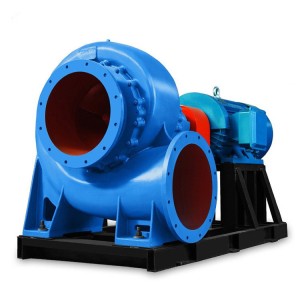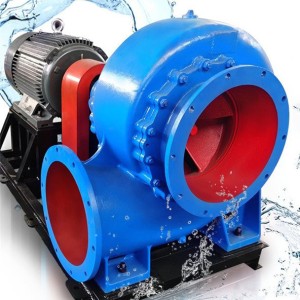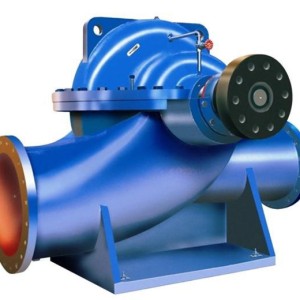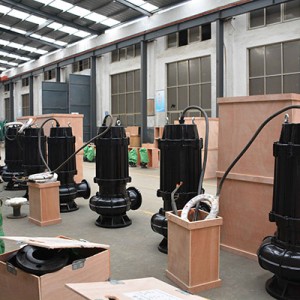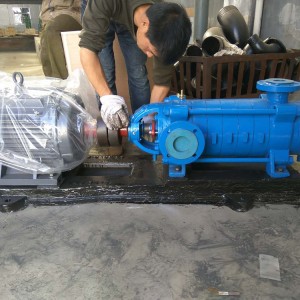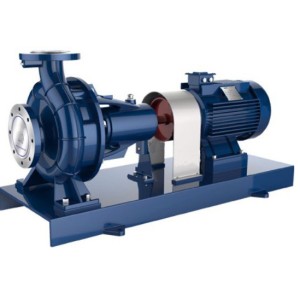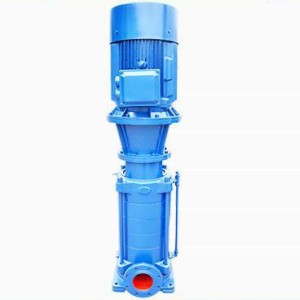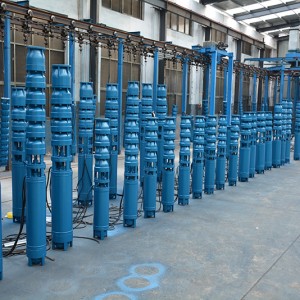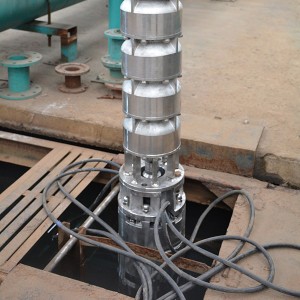The centrifugal pump is designed according to the principle of centrifugal force. The high-speed rotating impeller blades drive the water to rotate and throw the water out, so as to achieve the purpose of transportation. There are many types of centrifugal pumps, which can be divided into civilian and industrial pumps in terms of use; and can be divided into clean water pumps, impurity pumps, and corrosion-resistant pumps in terms of conveying media.
Horizontal centrifugal pump structure diagram (product use)
1. The pipeline centrifugal pump is used to transport clean water and other liquids whose physical and chemical properties are similar to clean water. It is suitable for industrial and urban water supply and drainage, high-rise buildings pressurized water supply, garden irrigation, fire pressurization and supporting equipment. The use temperature T is less than Equal to 80 degrees Celsius.
2. Hot water (high temperature) circulating pump is widely used in energy, metallurgy, chemical industry, textile, papermaking, and hotels and restaurants and other boilers for high-temperature hot water pressurized circulation and urban heating system circulation pumps, ISWR operating temperature T is less than or equal to 120 degrees Celsius , WRG operating temperature T is less than or equal to 240 degrees Celsius.
3. Horizontal chemical pumps are used to transport liquids that do not contain solid particles, are corrosive, and have a viscosity similar to water. They are suitable for petroleum, chemical, metallurgical, electric power, papermaking, food, pharmaceutical and synthetic fiber sectors. Use temperature T: Minus 20 degrees Celsius to 120 degrees Celsius.
4. Horizontal oil pump, used to transport petroleum products such as gasoline, diesel, kerosene, etc., operating temperature T: 20 degrees Celsius to 120 degrees Celsius
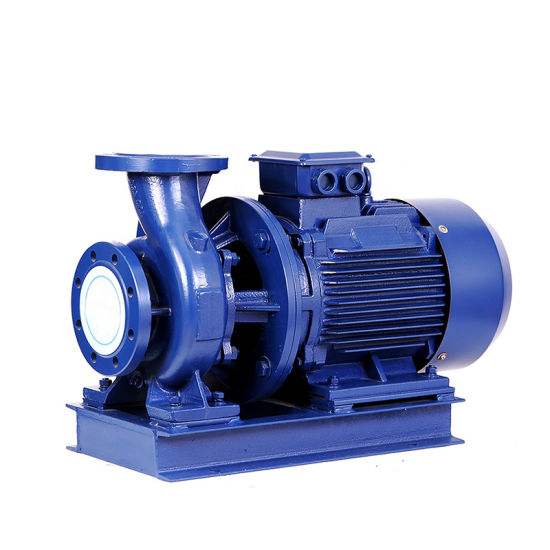
Horizontal centrifugal pump structure diagram (main features)
1. Smooth operation: The absolute concentricity of the pump shaft and the excellent dynamic and static balance of the impeller ensure smooth operation without vibration.
2. No leakage of dripping water: Carbide seals of different materials ensure that there is no leakage in the conveying of different media.
3. Low noise: The water pump supported by two low-noise bearings runs smoothly and is basically no noise except for the weak sound of the motor.
4. Low failure rate: The structure is simple and reasonable, and the key parts are equipped with international first-class quality, and the trouble-free working time of the whole machine is greatly improved.
5. Convenient maintenance: replacement of seals and bearings is simple and convenient.
6. Less land occupation: The outlet can be left, right, and up in three directions, which facilitates pipeline layout and installation and saves space.
Horizontal centrifugal pump structure diagram (main purpose)
1. ISW type horizontal clean water centrifugal pump is used to transport clean water and other liquids with physical and chemical properties similar to clean water. It is suitable for industrial and urban water supply and drainage, high-rise building pressurized water supply, garden sprinkler irrigation, fire pressurization, and long-distance transportation. , Heating, ventilation and refrigeration cycle, bathroom and other cold and warm water cycle pressurization and equipment supporting, the use temperature t ≤ 80 ℃.
2. ISWR type horizontal hot water pump is widely used in: metallurgy, chemical industry, textile, papermaking, hotels and restaurants and other boiler hot water pressurized circulating transportation and urban heating systems. The use temperature of iswr is t≤120℃.
3. ISWH type horizontal chemical pumps are used to transport liquids that do not contain solid particles, are corrosive and have a viscosity similar to water. They are suitable for petroleum, chemical, metallurgy, electric power, papermaking, food and pharmaceutical and synthetic fiber sectors. The operating temperature is -20℃~+120℃.
4. ISWB type horizontal pipeline oil pump is used for conveying gasoline, kerosene, diesel and other oil products or flammable and explosive liquids. The temperature of the conveyed medium is -20~+120℃.
Horizontal centrifugal pump structure diagram (main points of construction and installation)
1). The following re-checks should be made before the pump is in place; the size, location, and elevation of the foundation should meet the design requirements; the equipment should not be missing, damaged, or rusted, and the nozzle protection and blocking cover should be intact; the turning should be Flexible, no blocking, jamming, no abnormal sound.
2) Parts that have been assembled and debugged before leaving the factory should not be disassembled at will.
3) Leveling and alignment of pump installation. The height of the pump foundation above the ground should be convenient for pump installation and should not be less than 0.1m. After the pump is transported to the designated location, the equipment is hoisted and installed, and it is accurately located on the completed equipment foundation, and then put on the anchor bolts with nuts, put a shim under the base, and level the foundation with a level. Concrete is poured inside. After the concrete solidification period expires, perform leveling and tighten the anchor bolt caps. Each set of horns is fixed by spot welding, the surface of the foundation is roughened, and after washing with water, it is smoothed with cement mortar.
4). The pipeline installation should meet the following requirements:
(1) The inside and end of the pipe should be cleaned, the sealing surface and thread should not be damaged, and the flange end faces or thread axis lines of the interconnected flanges should be parallel and centered, and should not be forcibly connected. The weight of the pipeline should not be added to the pump, and should have its own support.
(2) After the pipeline is connected to the pump, welding and gas cutting should not be performed on it. If welding or gas cutting is required, the pipeline should be removed or necessary measures should be taken to prevent welding slag from entering the pump and damaging the pump parts .
After the installation is complete, there should be no friction or jamming when turning the pump shaft and impeller. Otherwise, the pump should be disassembled to check the cause.
(3) The piping configuration should be re-examined according to the equipment data and design drawings.
(4) Valves, check valves and pressure gauges should be installed on the outlet pipe of each water pump; when the pump directly draws water from the outdoor water supply pipe network, valves, check valves and pressure gauges should be installed on the suction pipe, and should be bypassed. The pump is provided with a bypass pipe equipped with a valve.
5) Vibration isolation and noise prevention of the water pump: flexible rubber joints or corrugated metal joints should be installed on the inlet and outlet pipes of the water pump; the pipe brackets should adopt elastic hangers and elastic brackets; in order to create a good vibration isolation effect, the foundation Vibration isolation, pipeline vibration isolation, and support vibration isolation must be in place. The area, number of layers, number, model of the vibration isolation pad (shock absorber), and the model and number of flexible joints must be selected according to the calculation results and Install. The parameters of the shock absorber, such as the model, positioning size, and the number of options, are directly related to the stability of the pump and the damping effect. The determination of this parameter must be confirmed by the accurate calculation of professional and technical personnel. Measures should be taken to prevent sound transmission from solid bodies at the places where the pump presses the pipes through walls and floors.
6), the main points of water pump debugging
Under the premise of ensuring safety, sensitivity and reliability of electrical control, perform a single test operation of the pump. Close the valve on the pump outlet pipe and gradually open it as the pump starts to run. Check for abnormalities, motor temperature rise, pump operation, and pressure gauge. Whether the numerical value and the tightness of the interface meet the requirements, etc.
Post time: 2021-11-30


